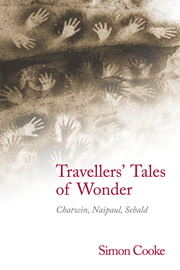Book contents
- Frontmatter
- Contents
- List of Illustrations
- Acknowledgements
- Introduction: The Wonder that Came Later
- I ‘Horizon of expectations’: Travels in Literary History
- II Readings in Contemporary Travellers' Tales of Wonder
- 4 Bruce Chatwin and the ‘modern WONDER VOYAGE’: In Patagonia (1977)
- 5 V. S. Naipaul and the ‘gift of wonder’: The Enigma of Arrival (1987)
- 6 W. G. Sebald's Travels through ‘das unentdeckte Land’: Die Ringe des Saturn (1995)
- Afterword: The ‘unlimited vicissitudes of travelling’
- Bibliography
- Index
5 - V. S. Naipaul and the ‘gift of wonder’: The Enigma of Arrival (1987)
from II - Readings in Contemporary Travellers' Tales of Wonder
Published online by Cambridge University Press: 05 October 2013
- Frontmatter
- Contents
- List of Illustrations
- Acknowledgements
- Introduction: The Wonder that Came Later
- I ‘Horizon of expectations’: Travels in Literary History
- II Readings in Contemporary Travellers' Tales of Wonder
- 4 Bruce Chatwin and the ‘modern WONDER VOYAGE’: In Patagonia (1977)
- 5 V. S. Naipaul and the ‘gift of wonder’: The Enigma of Arrival (1987)
- 6 W. G. Sebald's Travels through ‘das unentdeckte Land’: Die Ringe des Saturn (1995)
- Afterword: The ‘unlimited vicissitudes of travelling’
- Bibliography
- Index
Summary
And sometimes Pangloss would say to Candide:
‘All events form a chain in the best of all possible worlds. For in the end, if you had not been given a good kick up the backside and chased out of a beautiful castle for loving Miss Cunégonde, and if you hadn't been subjected to the Inquisition, and if you hadn't dealt the Baron a good blow with your sword, and if you hadn't lost all your sheep from that fine country of Eldorado, you wouldn't be here now eating citron and pistachio nuts.’
‘That is well put,’ replied Candide, ‘but we must cultivate our garden.’
Voltaire, Candide, or: Optimism (2000: 78)If Chatwin's In Patagonia had dazzled into literary consciousness an idea that ‘Patagonia’ as place and figurative possibility may still inspire, or require, wonder in the contemporary world, then V. S. Naipaul's The Enigma of Arrival is the late twentieth century's most exemplary and subtle monument to the idea that ‘after Patagonia’ there do indeed remain strange, distant and mysterious places in the world: ‘unknown Wiltshire’ (Naipaul 2002: 111), for example, deep in the archipelago of the British Isles. Before we even begin to explore The Enigma of Arrival as a text which both unflinchingly portrays and profoundly questions a sensibility of exhaustion, the author biographies that preface his books (amalgamated slightly here) might be enough to cast doubt on the idea of the completeness of the world picture that such a sensibility implicitly defers to:
V. S. Naipaul was born, of Indian ancestry, in Trinidad in 1932. He went to England on a scholarship in 1950. After four years at Oxford he began to write, and since then has followed no other profession. In 1960 he began to travel. He is the author of twenty-eight books of fiction and non-fiction and the recipient of numerous honours, including the Nobel Prize in 2001. He lives in Wiltshire, England.
- Type
- Chapter
- Information
- Travellers' Tales of WonderChatwin, Naipaul, Sebald, pp. 99 - 135Publisher: Edinburgh University PressPrint publication year: 2013

